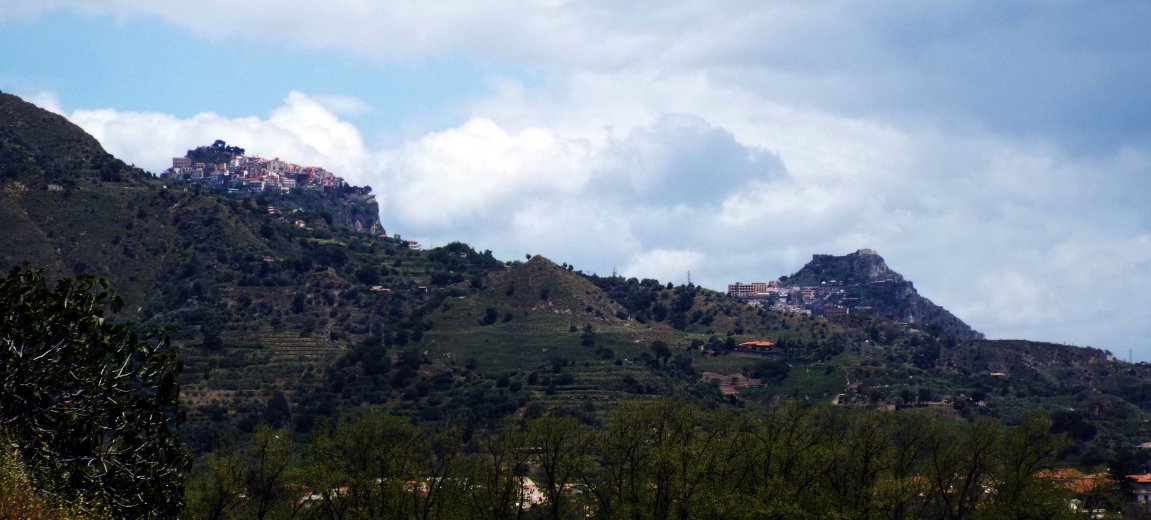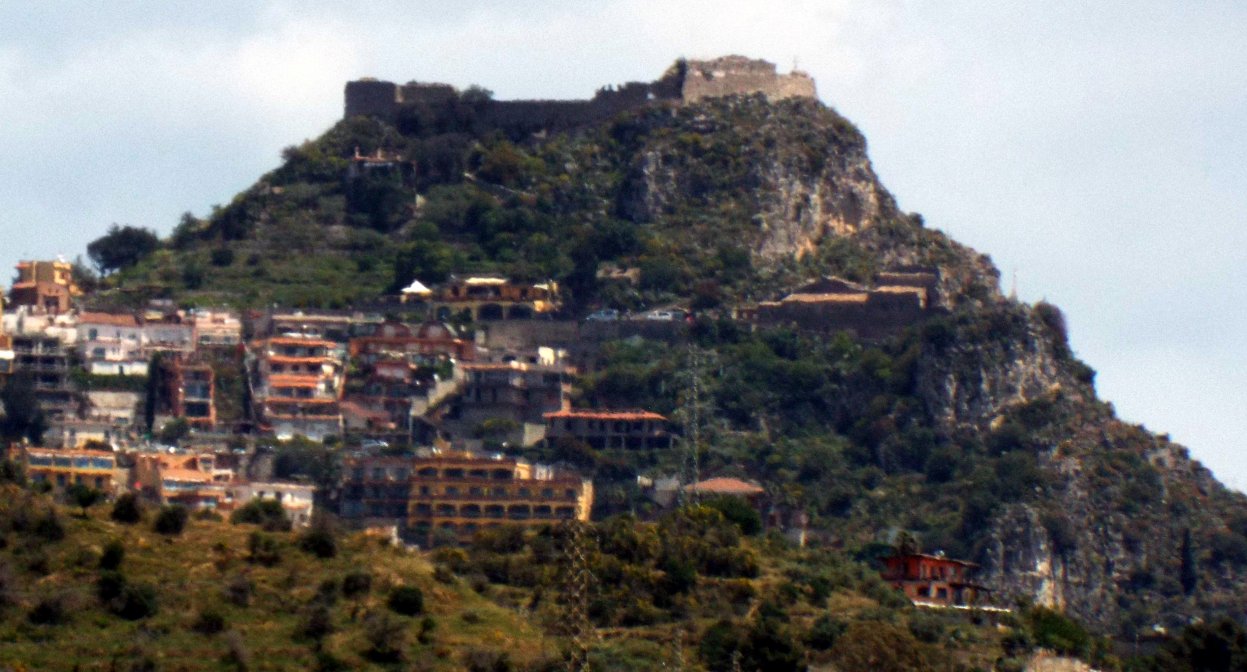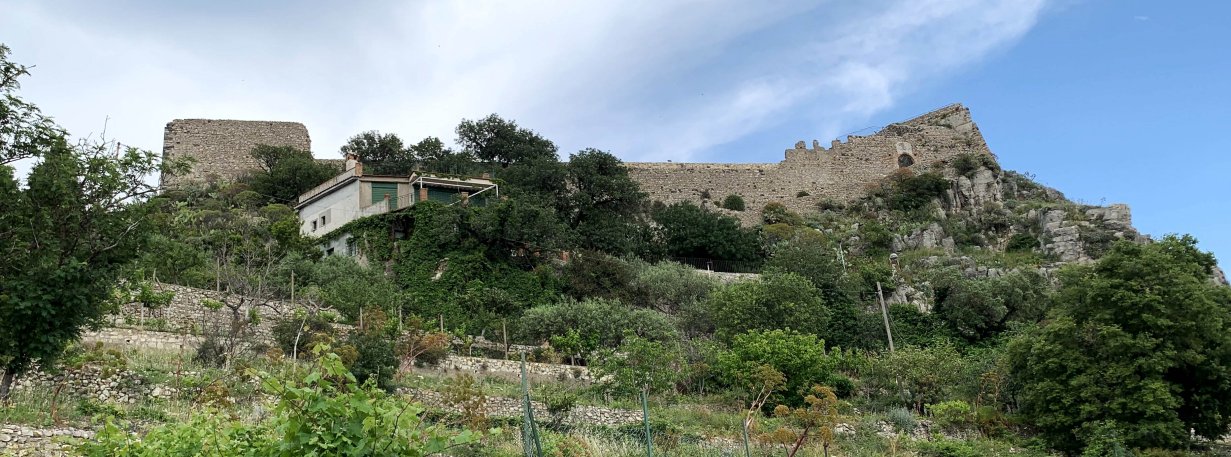Taormina
The castle is supposed to have been built on the site of the ancient acropolis of
the Greek town of Taormina. The Romans and later the
Byzantines must have strengthened the site. In August 902 AD the town
fell to the Muslims after a 2 year siege, although it is thought the castle held out a little longer. After a revolt the
fortifications of the town were razed to the ground in 969, by order of
the Emir Ahmad. After this the castle is said to have been
rebuilt into its present form with a trapezoid plan adapted to the
shape of the rock. However, this shape is typical of Byzantine
and hill top designs in general, viz: Calatabianco, Castelmola, Castronovo, Cefala Diana, Francavilla, Geraci Siculo, Mistretta, Nicosia, Rometta, Sperlinga and Vicari. The amount of Roman tile in
the walls would also suggest an early date.
In 1079, the Norman Count Roger Hauteville
(d.1101), conquered the town and presumably also the castle, from
the Muslims. The Normans, in order to avoid a long siege,
built 22 fortlets around the town and placed a fleet off the shore to
cut off any possible contact
with the outside. Despite a relief attempt which led to the death
of Everard, a Briton in Count Roger's employ, this strategy forced the
place to surrender in a few
months. By 1134 the castle was held by the San Salvatore la
Placa monastery which had been refounded by Count Roger between 1080
and 1093 northwest of Francavilla di Sicilia.
Later in 1150 Edrisi recorded a fortress built on the
top of a fortress and overlooking the town. By this he obviously
means the castle overlooking the Greek and Roman fortified town.
In 1168, after his arrest for lese majeste, Count Richard of Molise was:
taken to Taormina and guarded
with the utmost care in the fortress which is situated on the top of
the cliff, overhanging the town.
That same April the people of Messina
rebelled and moved against the castle with ‘the greatest stealth'
wishing to free the count. They seized the town without
difficulty, ‘but all their force could not capture the
castle'. After failing to bribe the castellan called Matthew and
threatening to kill his family, who had been taken in Messina, they
bribed the gatekeeper to open the gates. The gatekeeper then
freed Count Richard and armed him so that he could surprise and kill
Matthew, which he did, the people of Messina
then quickly took over the castle. Possibly the castle was then
destroyed for a century later in May 1272, it is quite surprising that
Taormina castle was not mentioned in a list of royal castle garrisons,
although nearby Castelmola
was.
Possibly this means Taormina castle was then either in private hands or
abandoned. The castle remained in the hands of the Crown,
although it was garrisoned by Peter Ruffo of Messina (d.1256+) after
the death of Frederick II in 1250. After his defeat at Piazza Armerina in November 1254 it was surrendered by him to the Messinans.
During the Sicilian Vespers of March 1282, on hearing news of the
uprising, the French commander of Messina, Herbert Orleans, sent a
Messinese garrison to hold Taormina under William Chiriolo.
Herbert then had second thoughts when he began to suspect the loyalty
of the Messinese and sent a French force to replace them.
Chiriolo was offended at this and captured his replacements, sending
them back as prisoner to the newly revolted Messina. Soon
afterwards Herbert surrendered Mategriffon castle and he and his
Frenchmen were allowed 2 ships to sail to France, never to set foot in
Italy again. However, Herbert broke his promise and sailed
directly to Catona, just over the straight. At this the
rebels threw the other captives in the second ship, including those who
had marched on Taormina, into the sea and drowned them all.
After Admiral Roger Lauria of Aci castle went over to the Angevins he
fought long and hard against King Frederick III (1295-1337). This
led to his assault on Taormina in 1300.
Finally, Roger and his men
left Thermae, passed through the straits of the lighthouse, and, with
Boreal blowing their sails, reached the shores of Taormina. Then
Roger, as he was a seeker of praise and glory in war, recalling to his
mind that he had hitherto feared nothing of the onslaught of wars,
suddenly attacked it by war and invaded it, from whence the ascent was
most difficult, as implacable as any that hindered it. And
although the townsfolk brought a great part of their possessions to the
castle which stood above them, nevertheless whatever spoils Roger's men
found in the homes of the fleeing inhabitants they carried back to
Catania as a sign of some victory over his enemies in this conflict.
In 1337 the Taormina castle was recorded as a royal fortress, while in 1353 it was obviously still operational for it was distinguished from Castelmola by being
called inferius. This is obviously true,
Castelmola lying at 1,850' and Taormina at 1,300'. The castle
was still in use in the fifteenth century when restorations and
modifications were recorded.

The case fills the rectangular summit of a 1,300 high hill, overlooking
the town. A narrow path leads up from the west to a gate
allowing access into a long barbican which rises up to the main ogival
gate in the western end of the south wall of the castle. The
internal arch is Romanesque. Overlooking this in the southwest
corner of the site is an internal trapezoid shaped tower.
This backs onto a roofless hall that covers the south side of the
site.
Externally the enceinte ranges from 13-25' high, but internally it can
be as low as only 2'. This is mainly to the east where the
wall has largely gone. To the north there are the remains of
an excruciatingly thin wallwalk, which in places is only about a foot
wide. This shows that they must be modern rebuilds as it
would have been suicidal to fight from such a position. The curtains
are of different ages and heights and red bricks and tiles abound in
the masonry. The bailey lay to the north and bears some
comparison with Montsegur castle in Languedoc.
Why not join me here and at other Sicilian
castles? Information on this and other tours can be found at Scholarly
Sojourns.
Copyright©2019
Paul Martin Remfry



